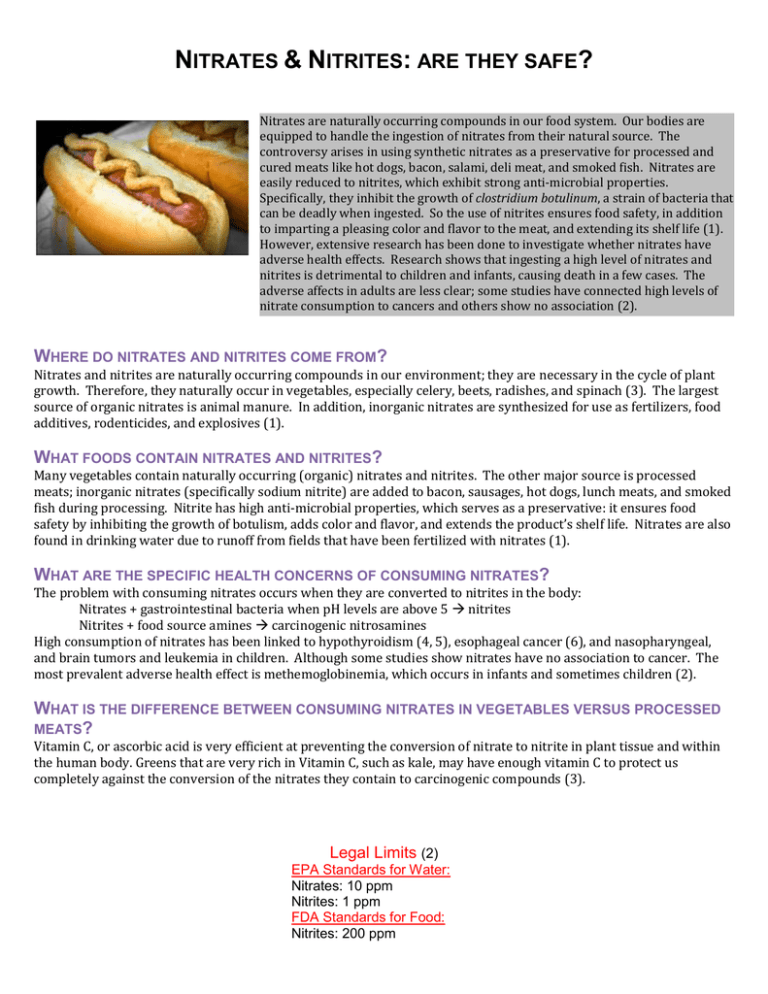Nitrates & Nitrites: are they safe?
advertisement

NITRATES & NITRITES: ARE THEY SAFE? Nitrates are naturally occurring compounds in our food system. Our bodies are equipped to handle the ingestion of nitrates from their natural source. The controversy arises in using synthetic nitrates as a preservative for processed and cured meats like hot dogs, bacon, salami, deli meat, and smoked fish. Nitrates are easily reduced to nitrites, which exhibit strong anti-microbial properties. Specifically, they inhibit the growth of clostridium botulinum, a strain of bacteria that can be deadly when ingested. So the use of nitrites ensures food safety, in addition to imparting a pleasing color and flavor to the meat, and extending its shelf life (1). However, extensive research has been done to investigate whether nitrates have adverse health effects. Research shows that ingesting a high level of nitrates and nitrites is detrimental to children and infants, causing death in a few cases. The adverse affects in adults are less clear; some studies have connected high levels of nitrate consumption to cancers and others show no association (2). WHERE DO NITRATES AND NITRITES COME FROM? Nitrates and nitrites are naturally occurring compounds in our environment; they are necessary in the cycle of plant growth. Therefore, they naturally occur in vegetables, especially celery, beets, radishes, and spinach (3). The largest source of organic nitrates is animal manure. In addition, inorganic nitrates are synthesized for use as fertilizers, food additives, rodenticides, and explosives (1). WHAT FOODS CONTAIN NITRATES AND NITRITES? Many vegetables contain naturally occurring (organic) nitrates and nitrites. The other major source is processed meats; inorganic nitrates (specifically sodium nitrite) are added to bacon, sausages, hot dogs, lunch meats, and smoked fish during processing. Nitrite has high anti-microbial properties, which serves as a preservative: it ensures food safety by inhibiting the growth of botulism, adds color and flavor, and extends the product’s shelf life. Nitrates are also found in drinking water due to runoff from fields that have been fertilized with nitrates (1). WHAT ARE THE SPECIFIC HEALTH CONCERNS OF CONSUMING NITRATES? The problem with consuming nitrates occurs when they are converted to nitrites in the body: Nitrates + gastrointestinal bacteria when pH levels are above 5 nitrites Nitrites + food source amines carcinogenic nitrosamines High consumption of nitrates has been linked to hypothyroidism (4, 5), esophageal cancer (6), and nasopharyngeal, and brain tumors and leukemia in children. Although some studies show nitrates have no association to cancer. The most prevalent adverse health effect is methemoglobinemia, which occurs in infants and sometimes children (2). WHAT IS THE DIFFERENCE BETWEEN CONSUMING NITRATES IN VEGETABLES VERSUS PROCESSED MEATS? Vitamin C, or ascorbic acid is very efficient at preventing the conversion of nitrate to nitrite in plant tissue and within the human body. Greens that are very rich in Vitamin C, such as kale, may have enough vitamin C to protect us completely against the conversion of the nitrates they contain to carcinogenic compounds (3). Legal Limits (2) EPA Standards for Water: Nitrates: 10 ppm Nitrites: 1 ppm FDA Standards for Food: Nitrites: 200 ppm NITRATES & NITRITES: ARE THEY SAFE? WHO IS MOST AT RISK? Infants, children and pregnant mothers are most at risk for adverse health effects related to nitrate and nitrite consumption. The ingestion of these compounds can lead to the formation of methemoglobin, which cannot bind with oxygen, thus decreasing the ability of the blood to transport oxygen to surrounding tissue. This condition is called methemoglobinemia (commonly referred to as “blue baby syndrome”) and is most prevalent in infants. Infants and children are more susceptible to this condition because of the high pH level in their gastrointestinal system, which creates optimal conditions for the conversion of nitrates to nitrites (2). WHAT ARE THE ENVIRONMENTAL CONCERNS? The most pressing environmental issue resulting from the use of nitrates and nitrites is the contamination of drinking water. The overabundance of these compounds used in fertilizers mainly in agriculture causes the formation of nitrates within the soil that then, because they are water soluble, leek into ground water. Because city water is monitored and filtered, drinking water contamination is generally only an issue in non-regulated private residential wells (1). ADVANTAGES OF NITRATE USE: Preserves cured meats thus increases shelf life Enhances the color of cured meats Deters the growth of harmful food borne bacteria (i.e., botulism) Effective fertilizers Effective rodenticide DISADVANTAGES OF NITRATE USE: Can cause methemoglobinemia in infants Can cause growth retardation, increased risk of SIDS, cardiac/nervous system defects & miscarriages if consumed during pregnancy May increase incidences of certain cancers in adults and children Can contaminate well water, thus increasing risk of overexposure RECOMMENDATIONS: *Get drinking water from a private well tested for nitrates annually. If anyone in the household is pregnant or nursing, testing should be done several times per year. *Minimize intake of smoked and cured meats; for pregnant or nursing women, these foods should be avoided altogether. *For formula-fed infants, the formula should be mixed with purified water. *Avoid feeding cured and processed meats to children. All of the recommendations above are an effort to minimize exposure to nitrates. Because they are a natural part of the food supply, eliminating them entirely is not possible. But since some evidence shows that excessive exposure to nitrates causes cancer, it is advisable to avoid overconsumption of nitrate-rich foods and water. NITRATES & NITRITES: ARE THEY SAFE? Resources: 1. Nitrate and Nitrite: Human Health Fact Sheet. Argonnne National Laboratory, EVS. https://docs.google.com/a/bastyr.edu/viewer?a=v&pid=gmail&attid=0.1.1&thid=13a7fe7ff507520f&mt =application/pdf&url=https://mail.google.com/mail/?ui%3D2%26ik%3D877c58bcfc%26view%3Datt% 26th%3D13a7fe7ff507520f%26attid%3D0.1.1%26disp%3Dsafe%26zw&sig=AHIEtbRRBTQvUugxd59X MdEJWh3dDv1_fQ. Accessed October 25, 2012. 2. United States Environmental Protection Agency. Nitrates and Nitrites: TEACH Chemical Summary. US EPA. http://www.epa.gov/teach/. Accessed October 25, 2012. 3. Kennedy, David. Leafy Vegetables and Nitrates. Leaf for Life. From http://www.leafforlife.org/PAGES/LEAFVEG.HTM. Published May 9, 1995. Accessed October 25, 2012. 4. Aschebrook-Kilfoy B, Heltshe SL, Nuckols JR, Sabra MM, Shuldiner AR, Mitchell BD, Airola M, Holford TR, Zhang Y, Ward MH. Modeled nitrate levels in well water supplies and prevalence of abnormal thyroid conditions among the Old Order Amish in Pennsylvania. Environ Health. 2012 Feb 17;11:6. 5. Khandelwal D, Tandon N. Overt and subclinical hypothyroidism: who to treat and how. Drugs. 2012 Jan 1;72(1):17-33. 6. Zhang N, Yu C, Wen D, Chen J, Ling Y, Terajima K, Akazawa K, Shan, Wang S. Association of nitrogen compounds in drinking water with incidence of esophageal squamous cell carcinoma in Shexian, China. Tohoku J Exp Med. 2012; 226(1), 11-7. 7. Carcinogen. Wikipedia. http://en.wikipedia.org/wiki/Carcinogen. Accessed October 25, 2012. 8. The Nitrate Debate. Last Chance Foods. http://culture.wnyc.org/articles/last-chancefoods/2012/mar/02/last-chance-foods-nitrate-debate/. Accessed October 25, 2012. 9. Nitrosamines and Cancer. The Linus Pauling Institute. http://www.studygs.net/citation.htm. Accessed October 25, 2012.








